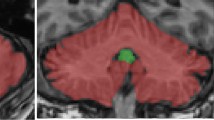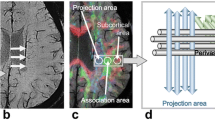Abstract
Purpose
This study aimed to investigate the diagnostic performance of diffusion kurtosis imaging (DKI) and diffusion tensor imaging (DTI) in identifying aberrations in the corticospinal tract (CST), whilst elucidating the relationship between abnormalities of CST and patients’ motor function.
Methods
Altogether 21 patients with WHO grade II or grade IV glioma were enrolled and divided into Group 1 and Group 2, according to the presence or absence of preoperative paralysis. DKI and DTI metrics were generated and projected onto the CST. Histograms of the CST along x, y, and z axes were developed based on DKI and DTI metrics, and compared subsequently to determine regions of aberrations on the fibers. The receiver operating characteristic curve was performed to investigate the diagnostic efficacy of DKI and DTI metrics.
Results
In Group 1, a significantly lower fractional anisotropy, radial kurtosis and mean kurtosis, and a higher mean diffusivity were found in the ipsilateral CST as compared to the contralateral CST. Significantly higher relative axial diffusivity, relative radial diffusivity, and relative mean diffusivity (rMD) were found in Group 1, as compared to Group 2. The relative volume of ipsilateral CST abnormalities higher than the maximum value of mean kurtosis combined with rMD exhibited the best diagnostic performance in distinguishing dysfunction of CST with an AUC of 0.93.
Conclusion
DKI is sensitive in detecting subtle changes of CST distal from the tumor. The combination of DKI and DTI is feasible for evaluating the impairment of the CST.








Similar content being viewed by others
References
Ricard D, Idbaih A, Ducray F et al (2012) Primary brain tumours in adults. Lancet 379:1984–1996. https://doi.org/10.1016/S0140-6736(11)61346-9
Ostrom QT, Price M, Neff C et al (2022) CBTRUS Statistical Report: Primary Brain and Other Central Nervous System Tumors Diagnosed in the United States in 2015-2019. Neuro Oncol 24:v1–v95. https://doi.org/10.1093/neuonc/noac202
Solomons MR, Jaunmuktane Z, Weil RS et al (2020) Seizure outcomes and survival in adult low-grade glioma over 11 years: living longer and better. Neurooncol Pract 7:196–201. https://doi.org/10.1093/nop/npz056
Jakola AS, Skjulsvik AJ, Myrmel KS et al (2017) Surgical resection versus watchful waiting in low-grade gliomas. Ann Oncol 28:1942–1948. https://doi.org/10.1093/annonc/mdx230
Li YM, Suki D, Hess K et al (2016) The influence of maximum safe resection of glioblastoma on survival in 1229 patients: Can we do better than gross-total resection? J Neurosurg 124:977–988. https://doi.org/10.3171/2015.5.JNS142087
Kuhnt D, Becker A, Ganslandt O et al (2011) Correlation of the extent of tumor volume resection and patient survival in surgery of glioblastoma multiforme with high-field intraoperative MRI guidance. Neuro Oncol 13:1339–1348. https://doi.org/10.1093/neuonc/nor133
Douek P, Turner R, Pekar J et al (1991) MR color mapping of myelin fiber orientation. J Comput Assist Tomogr 15:923–929. https://doi.org/10.1097/00004728-199111000-00003
Behrens TE, Berg HJ, Jbabdi S et al (2007) Probabilistic diffusion tractography with multiple fibre orientations: What can we gain? Neuroimage 34:144–155. https://doi.org/10.1016/j.neuroimage.2006.09.018
Tuch DS, Reese TG, Wiegell MR et al (2003) Diffusion MRI of complex neural architecture. Neuron 40:885–895. https://doi.org/10.1016/s0896-6273(03)00758-x
Jensen JH, Helpern JA, Ramani A et al (2005) Diffusional kurtosis imaging: The quantification of non-Gaussian water diffusion by means of magnetic resonance imaging. Magnet Reson Med 53:1432–1440. https://doi.org/10.1002/mrm.20508
Lazar M, Jensen JH, Xuan L et al (2008) Estimation of the orientation distribution function from diffusional kurtosis imaging. Magn Reson Med 60:774–781. https://doi.org/10.1002/mrm.21725
Gao B, Shen X, Shiroishi MS et al (2017) A pilot study of pre-operative motor dysfunction from gliomas in the region of corticospinal tract: Evaluation with diffusion tensor imaging. PLoS One 12:e0182795. https://doi.org/10.1371/journal.pone.0182795
Cepeda S, Garcia-Garcia S, Arrese I et al (2021) Acute changes in diffusion tensor-derived metrics and its correlation with the motor outcome in gliomas adjacent to the corticospinal tract. Surg Neurol Int 12:51–51. https://doi.org/10.25259/sni_862_2020
Smith SM, Jenkinson M, Woolrich MW et al (2004) Advances in functional and structural MR image analysis and implementation as FSL. Neuroimage 23(Suppl 1):S208–S219. https://doi.org/10.1016/j.neuroimage.2004.07.051
Woolrich MW, Jbabdi S, Patenaude B et al (2009) Bayesian analysis of neuroimaging data in FSL. Neuroimage 45:S173–S186. https://doi.org/10.1016/j.neuroimage.2008.10.055
Tabesh A, Jensen JH, Ardekani BA et al (2011) Estimation of tensors and tensor-derived measures in diffusional kurtosis imaging. Magn Reson Med 65:823–836. https://doi.org/10.1002/mrm.22655
Yeh FC, Tseng WY (2011) NTU-90: a high angular resolution brain atlas constructed by q-space diffeomorphic reconstruction. Neuroimage 58:91–99. https://doi.org/10.1016/j.neuroimage.2011.06.021
Faraji AH, Abhinav K, Jarbo K et al (2015) Longitudinal evaluation of corticospinal tract in patients with resected brainstem cavernous malformations using high-definition fiber tractography and diffusion connectometry analysis: preliminary experience. J Neurosurg 123:1133–1144. https://doi.org/10.3171/2014.12.JNS142169
Yushkevich PA, Gerig G (2017) ITK-SNAP: An Intractive Medical Image Segmentation Tool to Meet the Need for Expert-Guided Segmentation of Complex Medical Images. IEEE Pulse 8:54–57. https://doi.org/10.1109/MPUL.2017.2701493
Yushkevich PA, Piven J, Hazlett HC et al (2006) User-guided 3D active contour segmentation of anatomical structures: significantly improved efficiency and reliability. Neuroimage 31:1116–1128. https://doi.org/10.1016/j.neuroimage.2006.01.015
Wei X-E, Shang K, Zhou J et al (2019) Acute Subcortical Infarcts Cause Secondary Degeneration in the Remote Non-involved Cortex and Connecting Fiber Tracts. Front Neurol 10. https://doi.org/10.3389/fneur.2019.00860
Yu X, Jiaerken Y, Wang S et al (2020) Changes in the Corticospinal Tract Beyond the Ischemic Lesion Following Acute Hemispheric Stroke: A Diffusion Kurtosis Imaging Study. J Magn Reson Imaging 52:512–519. https://doi.org/10.1002/jmri.27066
Jiang R, Jiang J, Zhao L et al (2015) Diffusion kurtosis imaging can efficiently assess the glioma grade and cellular proliferation. Oncotarget 6:42380–42393. https://doi.org/10.18632/oncotarget.5675
Falk Delgado A, Nilsson M, van Westen D et al (2018) Glioma Grade Discrimination with MR Diffusion Kurtosis Imaging: A Meta-Analysis of Diagnostic Accuracy. Radiology 287:119–127. https://doi.org/10.1148/radiol.2017171315
Hempel JM, Schittenhelm J, Brendle C et al (2017) Histogram analysis of diffusion kurtosis imaging estimates for in vivo assessment of 2016 WHO glioma grades: A cross-sectional observational study. Eur J Radiol 95:202–211. https://doi.org/10.1016/j.ejrad.2017.08.008
Van Cauter S, Veraart J, Sijbers J et al (2012) Gliomas: diffusion kurtosis MR imaging in grading. Radiology 263:492–501. https://doi.org/10.1148/radiol.12110927
Pogosbekian EL, Pronin IN, Zakharova NE et al (2021) Feasibility of generalised diffusion kurtosis imaging approach for brain glioma grading. Neuroradiology 63:1241–1251. https://doi.org/10.1007/s00234-020-02613-7
Hempel JM, Bisdas S, Schittenhelm J et al (2017) In vivo molecular profiling of human glioma using diffusion kurtosis imaging. J Neurooncol 131:93–101. https://doi.org/10.1007/s11060-016-2272-0
Bisdas S, Shen H, Thust S et al (2018) Texture analysis- and support vector machine-assisted diffusional kurtosis imaging may allow in vivo gliomas grading and IDH-mutation status prediction: a preliminary study. Sci Rep 8:6108. https://doi.org/10.1038/s41598-018-24438-4
Gao A, Zhang H, Yan X et al (2022) Whole-Tumor Histogram Analysis of Multiple Diffusion Metrics for Glioma Genotyping. Radiology 302:652–661. https://doi.org/10.1148/radiol.210820
Xie S-h, Lang R, Li B et al (2023) Evaluation of diffuse glioma grade and proliferation activity by different diffusion-weighted-imaging models including diffusion kurtosis imaging (DKI) and mean apparent propagator (MAP) MRI. Neuroradiology 65:55–64. https://doi.org/10.1007/s00234-022-03000-0
Wang X, Gao W, Li F et al (2019) Diffusion kurtosis imaging as an imaging biomarker for predicting prognosis of the patients with high-grade gliomas. Magn Reson Imaging 63:131–136. https://doi.org/10.1016/j.mri.2019.08.001
Genc B, Aslan K, Ozcaglayan A et al (2023) The role of MR diffusion kurtosis and neurite orientation dispersion and density imaging in evaluating gliomas. J Neuroimaging. https://doi.org/10.1111/jon.13113
Zhang P, Gu G, Duan Y et al (2022) White matter alterations in pediatric brainstem glioma: An national brain tumor registry of China study. Front Neurosci 16. https://doi.org/10.3389/fnins.2022.986873
Zhou Z, Tong Q, Zhang L et al (2020) Evaluation of the diffusion MRI white matter tract integrity model using myelin histology and Monte-Carlo simulations. Neuroimage 223. https://doi.org/10.1016/j.neuroimage.2020.117313
Taha HT, Chad JA, Chen JJ (2022) DKI enhances the sensitivity and interpretability of age-related DTI patterns in the white matter of UK biobank participants. Neurobiol Aging 115:39–49. https://doi.org/10.1016/j.neurobiolaging.2022.03.008
Behler A, Kassubek J, Muller HP (2021) Age-Related Alterations in DTI Metrics in the Human Brain-Consequences for Age Correction. Front Aging Neurosci 13:682109. https://doi.org/10.3389/fnagi.2021.682109
Chen X, Weigel D, Ganslandt O et al (2007) Diffusion tensor imaging and white matter tractography in patients with brainstem lesions. Acta Neurochir (Wien) 149:1117–1131; discussion 1131. https://doi.org/10.1007/s00701-007-1282-2
Giordano M, Nabavi A, Gerganov VM et al (2015) Assessment of quantitative corticospinal tract diffusion changes in patients affected by subcortical gliomas using common available navigation software. Clin Neurol Neurosurg 136:1–4. https://doi.org/10.1016/j.clineuro.2015.05.004
Jiang RF, Hu XM, Deng KJ et al (2021) Neurite orientation dispersion and density imaging in evaluation of high-grade glioma-induced corticospinal tract injury. Eur J Radiol 140. https://doi.org/10.1016/j.ejrad.2021.109750
Delgado AF, Fahlstrom M, Nilsson M et al (2017) Diffusion Kurtosis Imaging of Gliomas Grades II and III - A Study of Perilesional Tumor Infiltration, Tumor Grades and Subtypes at Clinical Presentation. Radiol Oncol 51:121–129. https://doi.org/10.1515/raon-2017-0010
Jang S, Kim J, Seo Y et al (2017) Recovery of an injured corticobulbar tract in a patient with stroke: A case report. Medicine (Baltimore) 96:e7636. https://doi.org/10.1097/MD.0000000000007636
Jang SH, Lee J, Kim MS (2021) Dysphagia prognosis prediction via corticobulbar tract assessment in lateral medullary infarction: a diffusion tensor tractography study. Dysphagia 36:680–688. https://doi.org/10.1007/s00455-020-10182-3
Im S, Han YJ, Kim SH et al (2020) Role of bilateral corticobulbar tracts in dysphagia after middle cerebral artery stroke. Eur J Neurol 27:2158–2167. https://doi.org/10.1111/ene.14387
Khan MT, Prajapati B, Lakhina S et al (2021) Identification of Gender-Specific Molecular Differences in Glioblastoma (GBM) and Low-Grade Glioma (LGG) by the Analysis of Large Transcriptomic and Epigenomic Datasets. Front Oncol 11:699594. https://doi.org/10.3389/fonc.2021.699594
Lavrador JP, Gioti I, Hoppe S et al (2020) Altered Motor Excitability in Patients With Diffuse Gliomas Involving Motor Eloquent Areas: The Impact of Tumor Grading. Neurosurgery 88:183–192. https://doi.org/10.1093/neuros/nyaa354
Acknowledgements
None.
Funding
This study was supported by the Science and Technology Program of Guangzhou, China (grant number 202201011244).
Author information
Authors and Affiliations
Corresponding authors
Ethics declarations
Conflicts of interest
The authors declare no competing interests.
Ethics approval
This study was approved by the Institutional Review Board of our hospital and complied with the Declaration of Helsinki Ethical Principles.
Informed consent
Informed written consent was obtained from all patients. The patients and any identifiable individuals consented to publication of his/her image.
Additional information
Publisher’s note
Springer Nature remains neutral with regard to jurisdictional claims in published maps and institutional affiliations.
Rights and permissions
Springer Nature or its licensor (e.g. a society or other partner) holds exclusive rights to this article under a publishing agreement with the author(s) or other rightsholder(s); author self-archiving of the accepted manuscript version of this article is solely governed by the terms of such publishing agreement and applicable law.
About this article
Cite this article
Liu, X., Zeng, S., Tao, T. et al. A comparative study of diffusion kurtosis imaging and diffusion tensor imaging in detecting corticospinal tract impairment in diffuse glioma patients. Neuroradiology 66, 785–796 (2024). https://doi.org/10.1007/s00234-024-03332-z
Received:
Accepted:
Published:
Issue Date:
DOI: https://doi.org/10.1007/s00234-024-03332-z




